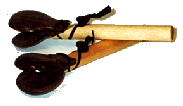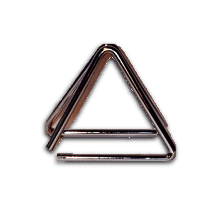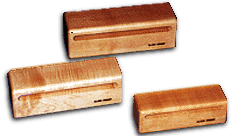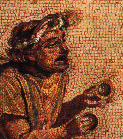|
Xtend
 Listen
Listen
 Jokes
Jokes
 Picture
Picture
 Dictionary
Dictionary
 Internet
Internet
 Projects
Projects
 Home
Home
|
 Castanets Castanets
 Cymbals
Unpitched percussion
These are instruments that produce
sounds that are not of a defined pitch. There purpose is to play the rhythm Cymbals
Unpitched percussion
These are instruments that produce
sounds that are not of a defined pitch. There purpose is to play the rhythm and accompany the tunes played in the orchestra
or band:
and accompany the tunes played in the orchestra
or band:
Castanets originated in Spain
originated in Spain .
Their shape is of two wooden cups, and they are mainly used for playing
music by composers inspired by the Spanish folk music, both Spaniards such
as Manuel de Falla .
Their shape is of two wooden cups, and they are mainly used for playing
music by composers inspired by the Spanish folk music, both Spaniards such
as Manuel de Falla ("the Three-Edged Hat")
and Granados
("the Three-Edged Hat")
and Granados ,
and other composers, like Bizet ,
and other composers, like Bizet ,
in his opera "Carmen" ,
in his opera "Carmen" . .
Cymbals are meant to intensify
the sound of the orchestra clapping one cymbal against another. The player
holds the leather stripes in the center of each one. Mozart gave the cymbals a solo in his opera "The
Magic Flute"
gave the cymbals a solo in his opera "The
Magic Flute" ,
and the overture to "Carmen"
emphasizes how Bizet uses
them to underline the rhythm of the orchestra. ,
and the overture to "Carmen"
emphasizes how Bizet uses
them to underline the rhythm of the orchestra.
Triangle

Gong
Triangle is made of a steel
bar bent into the shape of a triangle (hence its name), producing a gentle
sound by beating. It must be held by a string in order to avoid blocking
its sound.
Gong was brought to the orchestra from distant China
was brought to the orchestra from distant China ,
and its sound is like thunder roaring and
festive. A more mysterious sound can be achieved
by numerous weaker strikes, one after another. ,
and its sound is like thunder roaring and
festive. A more mysterious sound can be achieved
by numerous weaker strikes, one after another.
 Wood
Block Wood
Block
Wood block is a wooden box,
that, when struck with a wooden headed knocker, produces a sharp accurate
sound. Came from China . .
In addition to these instruments, other
percussion and noise instruments were integrated into the orchestra, especially
in the 20th century ,
in various pieces (a typing machine
by Leroy Anderson ,
in various pieces (a typing machine
by Leroy Anderson ,
car horns, rattles etc.) ,
car horns, rattles etc.)
"...and the Levites
the sons of Asaph with cymbals, to praise the LORD...þ" (Ezra,
chapter 3:10)

 Cymbals player from the
roman art
Cymbals player from the
roman art
|

The Triangle beside the player's feet
|
|
Composers

Mozart

Bizet

Granados

de Falla
|